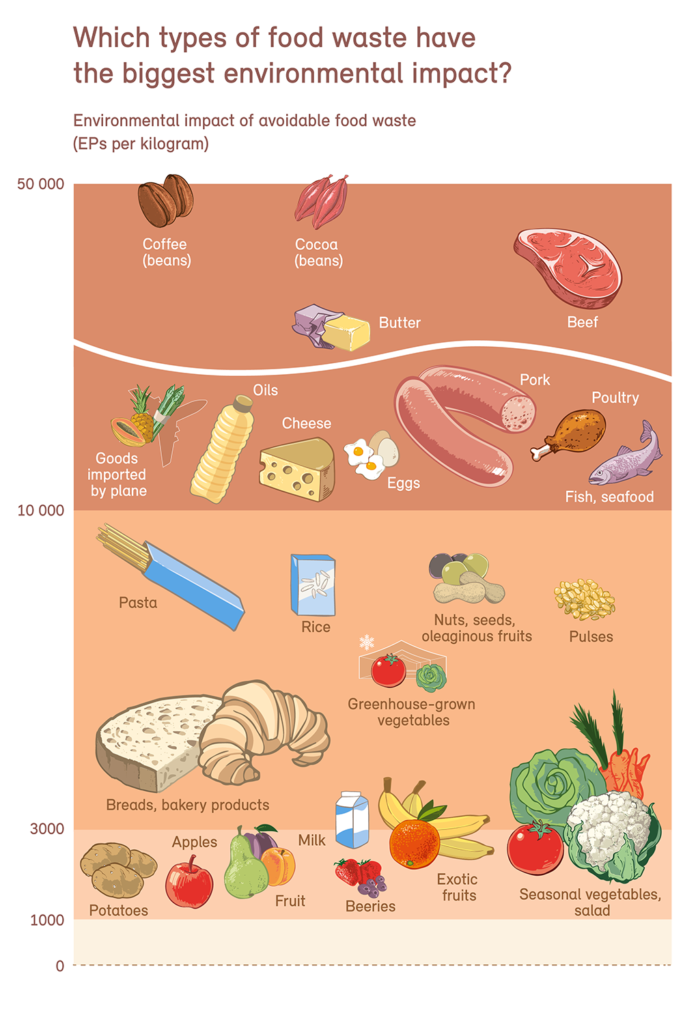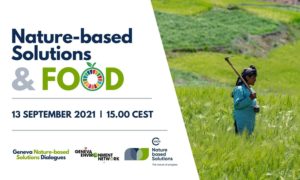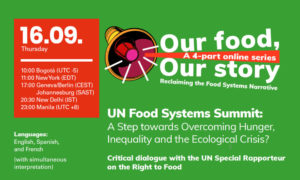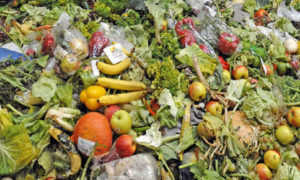Nouvelle
Food Systems and the Environment
Food systems touch every aspect of our lives, affecting our health, environment, economies and cultures. Food systems also have the power to bring us together as families, communities and nations. Rebuilding the food systems will enable us to answer the UN Secretary-General’s call to “build back better” from COVID-19 and as we are all part of the food system, we all must come together to bring about the transformation that the world needs.
Food Systems
The term “food system” refers to the constellation of activities involved in producing, processing, transporting and consuming food. Food systems touch every aspect of human existence. The health of our food systems profoundly affects the health of our bodies, as well as the health of our environment, our economies and our cultures. When they function well, food systems have the power to bring us together as families, communities and nations.
But too many of the world’s food systems are fragile, unexamined and vulnerable to collapse, as millions of people around the globe have experienced first-hand during the COVID-19 crisis. When our food systems fail, the resulting disorder threatens our education, health and economy, as well as human rights, peace and security. As in so many cases, those who are already poor or marginalized are the most vulnerable.
The good news is that we know what we need to do to get back on track. Scientists agree that transforming our food systems is among the most powerful ways to change course and make progress towards all 17 Sustainable Development Goals. Rebuilding the food systems of the world will also enable us to answer the UN Secretary-General’s call to “build back better” from COVID-19. We are all part of the food system, and so we all must come together to bring about the transformation that the world needs.

Source: International Resource Panel
2021 Food Systems Summit
In 2021, UN Secretary-General António Guterres will convene a Food Systems Summit as part of the Decade of Action to achieve the Sustainable Development Goals (SDGs) by 2030. The Summit will launch bold new actions to deliver progress on all 17 SDGs, each of which relies to some degree on healthier, more sustainable and equitable food systems. The Summit will also awaken the world to the fact that we all must work together to transform the way the world produces, consumes and thinks about food.
It is a summit for everyone everywhere – a people’s summit. It is also a solutions summit that will require everyone to take action to transform the world’s food systems. Guided by five Action Tracks, the Summit will bring together key players from the worlds of science, business, policy, healthcare and academia, as well as farmers, indigenous people, youth organizations, consumer groups, environmental activists, and other key stakeholders. Before, during and after the Summit, these actors will come together to bring about tangible, positive changes to the world’s food systems.
The pandemic has exposed the fragility of our food supply systems, from complex value chains to impacts on our ecosystems. But it has also demonstrated that businesses and people are ready to build back better. This crisis offers us a chance to radically rethink how we produce and consume food. For example, reorienting consumption by halving food waste and catalyzing a shift towards more plant-rich diets, is also a powerful climate mitigation tool to take advantage of. It is up to us to seize this opportunity and put sustainable food systems at the heart of the green recovery.
– Inger Andersen, Executive Director of the United Nations Environment Programme (UNEP), September 2020
Pre-Summit 2021
The Pre-Summit of the UN Food Systems Summit that took place in Rome, Italy, in hybrid format on 26-28 July 2021, set the stage for the culminating global event in September by bringing together diverse actors from around the world to leverage the power of food systems to deliver progress on all 17 SDGs.
The UN Food Systems Summit has revealed the 15 action areas with more than 50 solution clusters that served as a key element to underpin discussions at the Pre-Summit. Each action area, developed by more than 500 members of the Summit’s five Action Tracks, represents a cluster of game-changing propositions that aim to deliver the SDGs by transforming entire food systems.
Nature-based Solutions and Food Dialogue
As part of the Pre-Summit, the Geneva Environment Network and IUCN convened the Nature-based Solutions and Food Dialogue with leading experts on how NbS can represent a key pathway and contribute to established international and global targets. Adopting NbS approaches to better our food systems is essential to meeting the fundamental human right to food and contribute to multiple imperatives of the 2030 Sustainable Development Agenda.
Summit Objectives
The 2021 Food Systems Summit aims to deliver the following outcomes:
- Generate significant action and measurable progress towards the 2030 Agenda for Sustainable Development. The Summit will succeed in identifying solutions and leaders, and issuing a call for action at all levels of the food system, including national and local governments, companies and citizens.
- Raise awareness and elevate public discussion about how reforming our food systems can help us all to achieve the SDGs by implementing reforms that are good for people and planet.
- Develop principles to guide governments and other stakeholders looking to leverage their food systems to support the SDGs. These principles will set an optimistic and encouraging vision in which food systems play a central role in building a fairer, more sustainable world.
- Create a system of follow-up and review to ensure that the Summit’s outcomes continue to drive new actions and progress. This system will allow for the sharing of experiences, lessons and knowledge; it will also measure and analyze the Summit’s impact.
Principles of Engagement
The Food Systems Summit is guided by a set of seven principles of engagement. Underpinning each of these principles is the Summit’s vision of an equitable and healthy future for all, and one that gives voice to citizens in every country of the world. Everyone is invited to become a Food Systems Hero, host a Food Systems Dialogue, spread the word about food systems transformation, or find another way to support the Summit process. The Summit is open to all, and it belongs to us all. It is ours to create; we must define and build a strong food system, together. What does a strong food system mean?
- Act with urgency: We recognize the utmost urgency of sustained and meaningful action at all levels to reach the respective 2030 Sustainable Development Goals.
- Commit to the Summit: We commit to practice what we preach personally and professionally to contribute to the vision, objectives and the final outcomes of the Food Systems Summit.
- Be respectful: Within our respective capacities and circumstances, we will promote food production and consumption policies and practices that strive to protect and improve the health and well-being of individuals, enhance resilient livelihoods and communities and promote good stewardship of natural resources, while respecting local cultures, contexts.
- Recognize complexity: We recognize that food systems are complex, and are closely connected to, and significantly impact, human and animal health, land, water, climate, biodiversity, the economy and other systems, and their transformation requires a systemic approach.
- Embrace multi-stakeholder inclusivity: We support inclusive multi-stakeholder processes and approaches within governments and communities that bring in diverse perspectives, including indigenous knowledge, cultural insights and science-based evidence to enable stakeholders to understand and assess potential trade-offs and to design policy options that deliver against multiple public goods across these various systems.
- Complement the work of others: Recognizing that issues related to food systems are being addressed through several other global governance processes, we will seek to ensure that the Food Systems Summit aligns with, amplifies and accelerates these efforts where practicable, avoiding unnecessary duplication, while encouraging bold and innovative new thinking and approaches that deliver systems-level transformation in line with the Summit’s principles and objectives.
- Build trust: We will work to ensure the Summit and associated engagement process will promote trust and increase motivation to participate by being evidence-based, transparent and accessible in governance, decision-making, planning, engagement and implementation. We – from member states to private businesses to individual actors – will hold ourselves accountable for commitments made with mechanisms in place to uphold this accountability.
Environmental Impact of Food
Agriculture
According to the United Nations Economic Commission for Europe (UNECE), there is a two-way relationship between food production and air pollution: Food production contributes significantly to air pollution; in turn, air pollution can impact food production. Agriculture is the single largest contributor of ammonia pollution as well as emitting other nitrogen compounds. This affects soil quality and thus the very capacity of the soil to sustain plant and animal productivity. In addition, the growing trade in agriculture products in the last few decades has further increased the amount of pollution emitted from the intensification process in producer countries. As this burden remains in the producer country, it creates an imbalance and shifts the pollution problem from the importing countries to the producer countries.
Food Loss and Waste
According to the United Nations and the Food and Agriculture Organization (FAO), the global volume of food wastage is estimated at 1.6 billion tons of “primary product equivalents.” Total food wastage for the edible part of this amounts to 1.3 billion tons (figures of 2013). In July 2021, WWF and Tesco released “Driven to Waste: Global Food Loss on Farms”, a report revealing that an estimated 2.5 billion tonnes of food goes uneaten around the world each year, an increase of approximately 1.2 billion tonnes on the established estimates. This has an impact on the environment:
- Food wastage’s carbon footprint is estimated at 3.3 billion tons of CO2 equivalent of GHG released into the atmosphere per year.
- The total volume of water used each year to produce food that is lost or wasted (250km3) is equivalent to the annual flow of Russia’s Volga River, or three times the volume of Lake Geneva.
- Similarly, 1.4 billion hectares of land (28% of the world’s agricultural area) is used annually to produce food that is lost or wasted.
- Agriculture is also responsible for a majority of threats to at-risk plant and animal species tracked by the International Union for Conservation of Nature (IUCN).
- A low percentage of all food wastage is composted. Much of it ends up in landfills and represents a large part of municipal solid waste. Methane emissions from landfills also represent one of the largest sources of GHG emissions from the waste sector.
The later food is wasted along the chain, the greater its environmental impact because we have to take into consideration the energy and natural resources expended in processing, transporting, storing and cooking food. Food waste that ends up in landfills produces a large amount of methane – a more powerful greenhouse gas than even CO2. For the uninitiated, excess amounts of greenhouse gases such as methane, CO2 and chloroflurocarbons absorb infrared radiation and heat up the earth’s atmosphere, causing global warming and climate change.
With agriculture accounting for 70% of the water used throughout the world, food waste also represents a great waste of freshwater and ground water resources. It is said that a volume of water roughly three times the volume of Lake Geneva is used just to produce food that is not eaten. By throwing out one kilogram of beef, you are essentially wasting 50,000 liters of water that were used to produce that meat. In the same way, nearly 1,000 liters of water are wasted when you pour one glass of milk down the drain.
If you look at land usage, around 1.4 billion hectares of land, roughly a third the world’s total agricultural land area, is used to grow food that is wasted. Millions of gallons of oil are also wasted every year to produce food that is not eaten. All these do not even take into account the negative impacts on biodiversity due to activities like monocropping and converting wild lands into agricultural areas.
In “Enhancing Nationally Determined Contributions (NDCs) for Food Systems” it indicates that all the elements and activities that relate to the production, processing, distribution, preparation and consumption of food account for up to 37% of all greenhouse gas emissions; continuing on a business-as-usual trajectory will single-handedly exhaust the 1.5°C compatible emissions budgets for all sectors. Although 89% of NDCs mention agriculture production, agriculture emissions reduction targets are mainly included in wider land-use targets. More notably, other actions in the food system, such as reducing food loss and waste, or shifting to more sustainable diets, are widely ignored, despite presenting the combined opportunity to reduce emissions by as much as 12.5 Gt CO2e – the equivalent of taking 2.7 billion cars off the road.

Environmental impact in eco-points (EPs) per kilogram of avoidable food waste in households and the catering industry. The higher up the chart the category is, the greater the environmental impact per kilogram. Reusing food waste may mean that less animal feed, compost, etc. has to be produced. The environmental benefits of these savings have been taken into account in the calculation and in the chart. Image from the Swiss Federal Office for the Environment (FOEN).
SDG 12 – Sustainable Consumption and Production
The target of SDG 12 is to ensure sustainable consumption and production patterns, which contains a wide range of targets related to food waste. SDG Target 12.3 seeks to:
By 2030, halve per capita global food waste at the retail and consumer levels and reduce food losses along production and supply chains, including post-harvest losses.
In order to measure food waste and losses, two indices have been proposed.
Sub-Indicator 12.3.1.a – Food Loss Index
The Food Loss Index (FLI) focuses on food losses that occur from production up to (and not including) the retail level. It measures the changes in percentage losses for a basket of 10 main commodities by country in comparison with a base period. The FLI will contribute to measure progress towards SDG Target 12.3.
Sub-Indicator 12.3.1.b – Food Waste Index
A proposal for measuring Food Waste, which comprises the retail and consumption levels is under development. UNEP is taking the lead on this sub-indicator.
COVID-19: Reducing Food Loss and Waste
The COVID-19 pandemic continues to wreak havoc globally, generating significant challenges that could result in risks to food security and nutrition in many countries. Countries are ordering lockdowns, restricting movement and observing physical distancing to curb the pandemic. Disruptions in supply chains resulting from blockages on transport routes, transport restrictions and quarantine measures are resulting in significant increases in food loss and waste, especially of perishable agricultural produce such as fruits and vegetables, fish, meat and dairy products. In addition, labor shortages, owing to the restriction of movement of key stakeholders in production and transport, are significantly impacting food supply and demand owing to food shortages in some markets, further contributing to food loss and to the unnecessary waste of food supplies in these difficult times.
FAO encourages countries to adopt holistic approaches to tackle food loss and waste reduction, in an effort to facilitate access to food for all and particularly for vulnerable groups during the COVID-19 pandemic.
International Database
The Food Loss and Waste database is the largest online collection of data on both food loss and food waste and causes reported throughout the literature. The database contains data and information from openly accessible reports and studies measuring food loss and waste across food products, stages of the value chain, and geographical areas. In October 2019, more than 480 publications and reports from various sources (e.g., subnational reports, academic studies, and reports from national and international organizations such as the World Bank, GIZ, FAO, IFPRI, and other sources), which have produced more than 20,000 data points, were included. Data can be queried, downloaded, and plotted in an interactive and structured way. The database can be used by anyone who wishes to know more about food losses and waste.
Planet-Based Diet
According to WWF, eating a planet-based diet is high in human health benefits and low in environmental impacts. Adopting a planet-based diet can reduce:
- Food-based greenhouse gas emissions by at least 30%
- Wildlife loss by up to 46%
- Agricultural land-use by at least 41%
- Premature deaths by at least 20%
Role of Geneva
International Geneva
Organizations are listed in alphabetical order
Food and Agriculture Organization (FAO) Liaison Office in Geneva
FAO is a specialized agency of the United Nations that leads international efforts to defeat hunger and transform agri-food systems, making them more resilient, sustainable and inclusive. FAO’s goal is to achieve food security for all and make sure that people have regular access to enough high-quality food to lead active, healthy lives. Together with UNEP, FAO leads the UN Decade for Restoration.
FAO has also developed guidelines on sustainable food systems and value chain analysis, a standard tool that could be adapted to the COVID-19 context.
Global Alliance for Improved Nutrition (GAIN)
Headquartered in Geneva, GAIN is a Swiss-based foundation that works closely with governments, businesses and civil society to tackle global malnutrition and to transform food systems to provide everyone better access to nutritious, safe and affordable food. Ahead of the Food Systems Summit, GAIN has launched a partnership with the World Wildlife Foundation to deepen thinking on food systems transformation and to accelerate adoption of new solutions, all while leading the Summit’s Action Track.
International Institute for Sustainable Development (IISD)
Aiming to provide a world where people and the planet thrive work, the work of IISD focuses on accelerate solutions for a stable climate, sustainable resources, and fair economies. Recognizing the complexity of today’s challenges, they work on sustainable solutions on various fields such as food and agriculture, nature-based solutions, and climate change.
In the run up to the Food Systems Summit, the IISD has been providing companies, investment funds, and philanthropies new evidence that show how their concrete investment can end world hunger. They are also taking a look at the intersection of food systems, climate change and nutrition, to provide policymakers pathways that address these issues together.
International Labour Organization (ILO)
Through its Green Jobs Programme the ILO promotes the greening of enterprises, workplace practices and the labor market as a whole, which includes agriculture for food production. These efforts create decent employment opportunities, enhance resource efficiency and build low-carbon sustainable societies.
International Standard Organization (ISO)
ISO has more than 1,600 standards related to the food sector, with many more in development. The world population is growing rapidly and many food products repeatedly cross national boundaries to meet our rising demand for food. International Standards help to address this challenge in a safe and sustainable way, through guidance and best practice in food production methods and testing, to promote safety, quality and efficiency across the entire food industry.
International Trade Centre (ITC)
The work of ITC on Food and Agri-Business build sustainable agricultural exports and strengthen intraregional trade by assisting farmers, communities and agri-food enterprises while ensuring sustainability. ITC also works with small and medium enterprises and trade support institutions on organic farm production, with its environmental benefits while helping farmers mitigate and adapt to climate change.
International Union for Conservation of Nature (IUCN)
The work of IUCN on Nature-based solutions (NBS) and Sustainable Land Management provide an array of approaches for sustaining food production while safeguarding the ecosystem services upon which agriculture depends. They also provide benefits to society as a whole, in addition to positive externalities such as protecting water supply or mitigating climate change.
United Nations Conference on Trade and Development (UNCTAD)
As oceans and seas play a major role in contributing to achieving sustainable development, economic growth, and livelihoods, UNCTAD work on Oceans Economy and Fisheries supports developing countries in identifying opportunities and challenges that the oceans economy can bring. It also supports national trade and other competent authorities to design and create an enabling policy and regulatory environment that promotes the development and emergence of sustainable oceans economic sectors through the definition and implementation of national and regional oceans economy and trade strategies.
UNCTAD’s BioTrade Initiative also looks at products or services that sourced from biodiversity is commercialized and traded in a way that respects people and nature. The BioTrade Principles and Criteria (P&C) is a set of guidelines for businesses, governments and civil society wishing to support the conservation and sustainable use of biodiversity, as well as the fair and equitable sharing of benefits through trade.
United Nations Office for Disaster Risk Reduction (UNDRR)
UNDRR (formerly UNISDR) is the United Nations focal point for disaster risk reduction. UNDRR oversees the implementation of the Sendai Framework for Disaster Risk Reduction 2015-2030, supporting countries in its implementation, monitoring and sharing what works in reducing existing risk and preventing the creation of new risk. In the build-up to the UN Food Systems Summit, UNDRR calls on farmers, agri-food actors and DRR decision-makers to share their experiences in managing multiple risks for building resilient and sustainable agri-food systems.
United Nations Economic Commission for Europe (UNECE)
The quality standards of UNECE for the safe and transparent trade of food and agricultural produce ensure that the consumers in rural and urban areas receive a constant supply of high-quality, healthy and nutritious food. Maintaining the quality of food traded from the farm to the shop through international best practice reduces losses, enhances the economic value of food trade, opens income opportunities and alleviates health risks for the more vulnerable city dwellers. The trade in and availability of good quality food is a prerequisite for sustaining the growing population and facing the climate and environmental challenges.
The International Cooperative Programme on Effects of Air Pollution on Natural Vegetation and Crops assesses the impacts of air pollutants, particularly ground-level ozone, on crops. In addition, the International Cooperative Programme on Assessment and Monitoring of the Effects of Air Pollution on Rivers and Lakes assesses the degree and geographical extent of acidification of surface waters, which might end up in the oceans and affect habitat for fish. In addition, the Task Force on Reactive Nitrogen develops technical and scientific information and encourages coordination of air pollution policies on nitrogen in the context of the nitrogen cycle.
FeedUP@UN is also an innovative digital solution designed by UNECE for recording food lost or otherwise wasted. It is based on blockchain technology and brings all different parties together in one virtual space while contributing to a more circular production and responsible consumption.
United Nations Environment Programme Finance Initiative (UNEP FI)
UNEP FI works with banks, insurers, and investors to create a sustainable finance sector. As agriculture is one of the sectors most exposed to environmental risk caused by climate change and human degradation of ecosystems, UNEP FI has worked on a guide that enables financial institutions to conduct natural capital credit risk assessment across different agricultural sectors and geographies, taking into account factors such as water availability, use and quality; soil health; biodiversity; energy use and greenhouse gas emissions.
United Nations Human Rights (UNHCR)
The Special Rapporteur on the Right to Food addresses the need for an integrated and coordinated approach to promoting and protecting people’s right to food, for example, climate change and the right to food. It outlines the adverse impact of climate change on the right to food and places particular emphasis on the geographic and socioeconomic vulnerabilities of those most affected. It also highlights the negative impact that current agricultural practices and food systems are having on climate change. The current Special Rapporteur on the Right to Food is Michael Fakhri.
World Business Council for Sustainable Development (WBCSD)
WBCSD Food & Nature Program leads business efforts to accelerate the much-needed system transformation in the areas of food, nature and water. We do this by bringing leadership standards and tools, advocacy and projects across the value chain – from production to consumption – which deliver impact at scale where the urgent agendas of climate, nature and food systems intersect. The program also tackles food and agriculture and its Guide to Food System Transformation identified seven pathways where business must lead to drive system transformation and ensure delivery of the SDGs and the Paris Climate Agreement. We address climate resilience and mitigation, nature and biodiversity loss, livelihoods and human rights, and nutrition and health.
World Economic Forum (WEF)
Among the global issues covered by WEF is the “Future of Food” proving strategic analysis, trends and research on the topic.
World Food Programme (WFP) Office in Geneva
WFP work on sustainable livelihoods and ecosystems helps countries and the most vulnerable and food insecure communities manage natural resources sustainably such as soil conservation and fertility measures; water harvesting and flood control; agro-ecological productivity to reduce biodiversity loss; irrigation schemes; forestry and agroforestry management; and, access to clean water in arid and semi-arid contexts results in more diversified food, thereby complementing nutrition efforts. The restoration of degraded ecosystems boosts public health and reduces hardship in general.
In its work on climate action, WFP also provides analysis highlighting the links between food security and climate risks, as well as the present and future impact of climate change on food security and nutrition.
World Intellectual Property Organization (WIPO)
The Global Challenges Division of WIPO addresses innovation and IP at the nexus of interconnected global issues, in particular global health, climate change and food security. It identifies opportunities to apply and scale up innovation-driven solutions that improve peoples’ lives. The Division engages across a wide range of intellectual property-related global policy discussions and partners with a broad cross-section of stakeholders, contributing to the shared realization of the SDGs.
WWF International
WWF works on projects that improve efficiency and productivity in food systems while reducing waste and shifting consumption patterns. WWF also builds public awareness on how we consider food.
Switzerland and Local Geneva
Organizations are listed in alphabetical order
Biovision
In October 2020, Biovision launched a platform on sustainable agriculture and food systems with the support of Switzerland and Germany. Its “Food Policy Forum for Change” offers interested actors the opportunity to learn more about success stories of sustainable food system transformation and to exchange experiences among peers and the first platform to focus consistently on agroecological approaches. Biovision’s program CLEVER also builds awareness on responsible food consumption.
Canton and City of Geneva
The Canton of Geneva imports approximately 80% of the commodities consumed by its population. The transport of food products is the third-largest flow of resources consumed in Geneva after building materials and energy products. The Canton of Geneva provides resources on food waste and the City of Geneva lists tools on learning how to adopt to a local and sustainable approach to eating.
Fédération Romande des Consommateurs (FRC)
FRC provides tools for consumers to avoid food waste.
Partage
Partage is a food bank created in 2005 by the Salvation Army, C.A.R.E., Caritas Genève, les Colis du Cœur and Emmaüs. It salvages food waste and provides them to different beneficiaries.
Swiss Federal Office for the Environment
The Swiss Federal Office for the Environment provides information on food waste in Switzerland. About 25% of the country’s nutrition-related environmental impact is caused by avoidable food waste. In 2013, the Swiss Federal Council adopted measures to reduce food waste as part of the Green Economy Action Plan. Among others, it has resulted in a stakeholder dialogue and the implementation of a number of initial actions. With the adoption of the Chevalley postulate (18.3829) on 5 March 2019, the National Council mandated the Federal Council to produce an action plan on food waste prevention.
WWF Switzerland
The Swiss organization of WWF provides resources and an app on food waste.
Zero Waste Geneva
Zero Waste Geneva is a community for those looking to reduce waste, preserve natural resources and create a more sustainable future! The organization offers workshops and resources on reducing food waste.
Events

Nature-based Solutions and Food: Geneva Nature-based Solutions Dialogues
13 September | 15:00 CEST | Geneva Environment Network and IUCN

HRC48 Side Event | A Step towards overcoming Hunger, Inequality and the Ecological Crisis? | Critical dialogue with the UN Special Rapporteur on the Right to Food
16 September | 17:00 – 19:00 CEST | Rosa-Luxemburg-Stiftung and FIAN Int.
Learning

Food Loss Analysis E-Learning Course
Online | FAO

Quiz Gaspillage Alimentaire
Online | Fédération Romande des Consommateurs
Resources
Articles
- Counting carbon in the food export business | Alexander Kasterine | 9 November 2021
- Most agricultural funding distorts prices, harms environment: UN report | UN News | 14 September 2021
- World leaders and experts call for significant reduction in the use of antimicrobial drugs in global food systems | WHO | 24 August 2021
- UN Report: Pandemic Year Marked by Spike in World Hunger | WHO | 12 July 2021
- Scientists Reject Proposed “IPCC for Food” | Geneva Solutions | 12 July 2021
- Whose Seeds Are They Anyway? Peasants’ Call for Common Ownership | Geneva Solutions | 9 July 2021
- Climate Change Threatens Age-Old Indigenous Food Systems, Says UN | WEF | 30 June 2021
- Five Ways We Can Reduce Food Emissions to Keep Global Temperatures Down | WEF | 23 June 2021
- Trade and Food Security: When an Agreement Delayed Becomes a Human Right Denied | UNCTAD | 7 June 2021
- Rethinking Food Systems | UNEP | 4 June 2021
- Why Trade Must Be Part of the Solution to Biodiversity Loss | UNCTAD | 21 May 2021
- EU and FAO Call for the Transformation of Agri-Food Systems | Scaling Up Nutrition | 10 May 2021
- Nature-based Solutions Can Save the Planet, But Only If We Change Our Diets Too | WEF | 12 March 2021
- Serving Up Sustainable Food | UNEP | 20 January 2021
- Green Technology for Food and Agriculture | WIPO | 16 October 2020
- Food Lost and Wasted: The Invisible Face of Our Food Chain and an Opportunity for Change | UNECE | 29 September 2020
- Transformation of Our Food Systems – Making of a Paradigm Shift | Hans R. Herren, Benedikt Haerlin and the IAASTD+10 Advisory Group | 28 September 2020
- Why Sustainable Food Systems are Needed in a Post-COVID World | UNEP | 14 July 2020
- Hungry for Change: The Global Food System | UNEP | 18 June 2020
- Food for Thought: Dietary Changes Can Improve Our Health, Health of Planet | UNEP | 25 November 2019
Reports
- A multi-billion-dollar opportunity – Repurposing agricultural support to transform food systems | FAO, UNDP & UNEP | 14 September 2021
- Interim report of the Special Rapporteur on the right to food, Michael Fakhri to the UNGA (A/76/237) | UN | 27 July 2021
- Driven to Waste: Global Food Loss on Farms | WWF and Tesco | 21 July 2021
- The State of Food Security and Nutrition in the World 2021 | FAO, IFAD, UNICEF, WFP and WHO | 12 July 2021
- Towards a Harmonized International Trade Classification for the Development of Sustainable Ocean-Based Economies | UNCTAD | 16 March 2021
- Food Waste Index Report 2021 | UNEP | 4 March 2021
- Policy Brief: Towards a New Trade Agenda for the Right to Food | UNCTAD | March 2021
- Trade, Food Security and Sustainable Agriculture | UNCTAD |2021
- Innovative Technologies Tackling Food Loss | WIPO |2020
- Innovation with a Purpose: The Role of Technology Innovation in Accelerating Food Systems Transformation | WEF | January 2018
- Nature-based Solutions for Agricultural Water Management and Food Security | FAO | 2018
- Food Security Policies: Making the Ecosystem Connections | IUCN | 2013
- How the Private and the Public Sectors Use Intellectual Property to Enhance Agricultural Productivity | WIPO | 14 June 2011
Documentaries with Expert Interventions
- Wednesdays for the Planet: Organic Food – Hype or Hope? | Geneva Environment Network | 9 June 2021
- Wednesdays for the Planet: The Fish on My Plate | Geneva Environment Network | 19 May 2021
- Wednesdays for the Planet: Sustainable Food for a Sustainable Future | Geneva Environment Network | 5 May 2021
Podcasts and Short Videos
- Future of Food Systems | Devex
- This is How Farming Shrimp Can Restore Our Coastlines and Create Jobs | WEF | 9 June 2021
- Food Waste, Food Loss and the Role of Packaging | WBCSD


